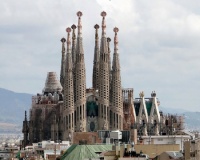Sagrada Familia (1882)
An Unfinished Masterpiece[edit]
La Sagrada Família is an impressive, although incomplete, church in Barcelona designed by the famous Catalan architect Antoni Gaudí (1852–1926). Gaudí took over design and construction of the church from Francisco de Paula del Villar (1828-1901) in 1883 and continued until his death in 1926, injecting his unique style into the project. Its cultural significance, besides sheer beauty, is twofold. Firstly, it is positioned centrally in Barcelona in both a physical and iconic sense, given the notoriety of Gaudí and the level of international interest he brought to the region artistically. Along with six other of his buildings, Sagrada Família’s UNESCO World Heritage Site status is testament to Gaudí enormous influence on artistic architecture throughout the world. Furthermore, secondly, the architectural style of Sagrada Família itself demonstrates a multicultural spirit as it draws on aspects of design that are international in nature. As combination of Gothic and Art Nouveau, it represents a homogeny of cultural heritage in style, and Art Nouveau itself holds the philosophy of art as in harmony with nature, transcending national and cultural identity. This is accentuated by the fact that construction is still ongoing to this day, and therefore the architectural style is open to interpretation by the architects involved since Gaudí’s death.
